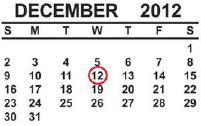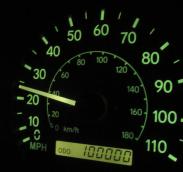
I've always been amused by coincidental numerical patterns. Watching the odometer of my car, I don't notice only major milestones such as 100,000 miles. I also notice things like increasing sequences (123456) and palindromes (123321). You probably recall that a palindrome is something that reads the same forward and backward. 12/12/12 is the last major repeating date for a while. The next one won't occur until January 1, 2101, which can be written 01/01/01. But it's only a repeating date if you allowed the month and the day to be written with leading zeros, otherwise it would be written 1/1/01 (a two-digit year less than 10 is always written with a leading zero). If you disallow leading zeros in the month and the day, you'll have to wait for 10/10/10, in other words October 10, 2110. In either case, it's obvious that I won't see this happen again.
As with my odometer, I notice patterns on the face of this clock. To the right, it's showing the palindrome "14241", which occurred, of course, earlier this afternoon at 1:42:41.
The Anelace clock is fun because I'm often the only person in the room who can read it. The code that represents numbers with four binary bits is called "hexadecimal" in the computer field, and it is so commonly used that computer programmers have long since learned all the patterns. Two women in my French discussion group have backgrounds in the computer field. When someone in the group asked how to read the clock, all I had to say was, "Read each column as BCD, reading top to bottom." That was all it took to enable them to immediately read the clock. Actually, I think they had already figured it out for themselves after a few seconds of watching the right-hand column count in binary. The "Conventions" page on my blog has a section on how I write dates. I always try to write them out in full, to avoid ambiguity. This is because the American form for written dates is different from the form used in most European countries and other places in the world. Yesterday, December 11, 2012 would be written 12/11/12 in the United States, but would be written 11/12/12 in most other countries. Today, of course, there would be no problem, as it would be 12/12/12 everywhere. But as I pointed out above, that won't occur again in our lifetimes. In the past, these different date formats have occasionally caused serious problems. During World War II, General Dwight David Eisenhower insisted that all dates have their months written out, generally with a three letter abbreviation. Thus, yesterday's date would have been written 11-DEC-12. This was done because abbreviating the month numerically was causing confusion between American and British troops. As it turned out, the date of D-Day, 6/6/44, would not have been confusing, but that was just happenstance. Although I find number patterns amusing, some people read a lot more into them than I do. The current Wikipedia entry on numerology begins, "Numerology is any study of the purported divine, mystical or other special relationship between a number and some coinciding observed (or perceived) events." Consider the purported significance of the number 666 in the Biblical Book of Revelation, where it's called the "Mark of the Beast". You can find out a lot about numerology by doing your own searches on the Internet, a fine source for wide-ranging information about this and other forms of bullshit. Or take a look at Numerology: Or, What Pythagoras Wrought, by Woody Dudley. His definition of numerology is, "The delusion that numbers have power over events."
I later got more information about the photo from Elissa. You can see from the speedometer that the car was in motion when it was taken. It was taken on a vacation in Kennebunkport, Maine, by Elissa's husband Ryan, leaning over from the front passenger seat. Elissa had previously checked out the photographic conditions as the magic number approached. I think that lacking Elissa's odometer-watching gene, Ryan was a bit mystified by this project, but he gamely went along with it. Perhaps the tendency to write a blog is also inherited. Maybe someday a "blogging gene" will be discovered on the seventeenth chromosome. Because it turns out that like me, Sara also has a blog. And I just found out that she chose to post an entry today which is, at least in part, about the date 12/12/12. You can see Sara's entry on her Innovation on Earth blog ←(click that link to see it). It includes a video of her school's students celebrating today at exactly 12:12 on 12/12/12. To tell the truth, I think that her blog entry today is more interesting than mine.   |
 I'm posting this blog entry a day earlier than usual because I wanted to have an entry dated 12/12/12.
I'm posting this blog entry a day earlier than usual because I wanted to have an entry dated 12/12/12.
 I have an
I have an  Palindromes obviously occur a minute apart, at least as long as there's only one digit for the hour. Thus at any given moment, I don't have to wait too long to see another interesting pattern. But on the BCD clock, there are other interesting patterns that are purely geometrical, such as the "box", seen to the left, that appears on the display at 7:55:57. This pattern happens to also be a palindrome, but there are other interesting geometrical patterns that are not.
Palindromes obviously occur a minute apart, at least as long as there's only one digit for the hour. Thus at any given moment, I don't have to wait too long to see another interesting pattern. But on the BCD clock, there are other interesting patterns that are purely geometrical, such as the "box", seen to the left, that appears on the display at 7:55:57. This pattern happens to also be a palindrome, but there are other interesting geometrical patterns that are not.
 My watching for odometer patterns was noted in an earlier blog entry,
My watching for odometer patterns was noted in an earlier blog entry,  Then, when I posted this entry, I got an immediate message from my other daughter, Elissa, with the photo to the left. It seems that she had also taken a picture of her odometer at an important milestone. She wrote, "100,000! From March 2012. So yes, perhaps inherited."
Then, when I posted this entry, I got an immediate message from my other daughter, Elissa, with the photo to the left. It seems that she had also taken a picture of her odometer at an important milestone. She wrote, "100,000! From March 2012. So yes, perhaps inherited."